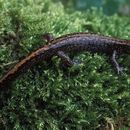Description
provided by AmphibiaWeb articles
No lungs. Vomerine teeth in two arch-shaped continuous series; generally no gap between them. Parotoids developed moderately. Costal grooves 13-14, well-developed. Tail long, cylindrical at the base and slightly compressed at the end, slightly longer than the body with head. Toes five. Coloration brown or brown-greyish, with dark points and obscure dorsal golden or brownish band which may be divided into large spots. Light dorsal band is very marked. Males have a relatively shorter tail and relatively longer forelegs than females, and a lateral fold on the hind leg between the 5th toe and tibia.
- Akita, Y. (1982). ''[Notes on the egg-laying site of Onychodactylus japonicus on Mt. Hodatsu].'' Japanese Journal of Herpetology, 9(4), 111-117.
- Akita, Y. (1983). ''[External characters of Onychodactylus japonicus from Mt. Hodatsu in the breeding season].'' Japanese Journal of Herpetology, 10(2), 62.
- Akita, Y. (1983). ''[Winter reproduction of Onychodactylus japonicus].'' Ryoseihatorui Kenkukaishi, 26.
- Akita, Y. (1991). ''[Notes on the hatching of Onychodactylus japonicus inhabiting in Mt. Hodatsu, Ishikawa Pref.].'' J. Nat. Hist. Japan, 1.
- Kuzmin, S.L. (1995). The Clawed Salamanders of Asia (Genus Onychodactylus). Westarp Wissenschaften, Magdeburg.
Distribution and Habitat
provided by AmphibiaWeb articles
The species inhabits the islands of Honshu and Shikoku and is not known to occur outside these territories. Onychodactylus japonicus inhabits mountainous regions covered by mixed forests with abundant streams, and moss-covered rocks and stony ground. There the salamander lives in very moist, cool, shady places where direct sunlight is absent. The most suitable habitats are dense bushlands and woodlands near small rivers, brooks and lakes, usually of northern exposure. The animals prefer to remain close to springs and near waterfalls, although occasionally the salamanders are found far from bodies of water. Within the population range, adults seem to be restricted to a few places where conditions are most suitable. The salamanders occur usually under the rocks, stones, tree roots, logs, and in the holes of fallen trees. The water is required to be quite clear and cool.
Life History, Abundance, Activity, and Special Behaviors
provided by AmphibiaWeb articles
The Japanese Clawed Salamander is not a rare species. Moreover, it is locally quite abundant, and thousands of individuals may be recorded during autumn migrations. Hibernation occurs from November-December to April on land (under logs, roots of trees etc.). However, there are indications on the disruption of the hibernation period, at least in some populations. The reproductive period is estimated from April to June and, in the northern part of the range, from July to the first week of August. More detailed data, collected by Y. Akita on Hodatsu Mountain, Ishikawa Prefecture, revealed two spawning periods at a single breeding site: in May-July and October-December. Reproduction occurs in the underground part of the stream; pairs of rod-shaped egg sacs are attached to stones in the innermost recess of a small underground cavity where cold springs emerged from under stones to form the headwater of a mountain brook. The clutch contains about 10-24 eggs. The reproductive mode in O. japonicus indicates its strong dependence on cool, permanent water and the availability of suitable hiding places. Hatchlings appear to stay at the hatching site for several months, before migrating downstream. Total duration of the embryonic and larval period is not known. Probably, it takes more than one year. The larvae feed on small brook invertebrates; adults, in addition, take terrestrial prey, mainly arthropods.
Life History, Abundance, Activity, and Special Behaviors
provided by AmphibiaWeb articles
Level of anthropogenic pressure may be high in urbanized areas. In some places, local people collect adult salamanders in masses during their migrations for medicinal use. However, the impact of this practice on salamander populations is unclear.
Lifespan, longevity, and ageing
provided by AnAge articles
Maximum longevity: 14.2 years (captivity)
- license
- cc-by-3.0
- copyright
- Joao Pedro de Magalhaes
- editor
- de Magalhaes, J. P.
Japanese clawed salamander
provided by wikipedia EN
- license
- cc-by-sa-3.0
- copyright
- Wikipedia authors and editors
Japanese clawed salamander: Brief Summary
provided by wikipedia EN
The Japanese clawed salamander (Onychodactylus japonicus) is a species of salamander in the family Hynobiidae, endemic to Japan. Its natural habitats are temperate forests and rivers.
- license
- cc-by-sa-3.0
- copyright
- Wikipedia authors and editors

